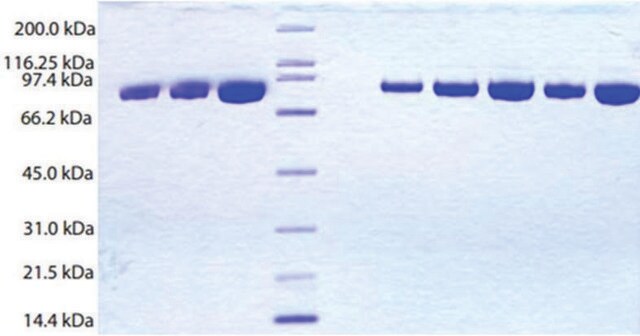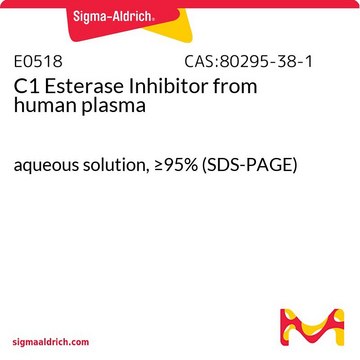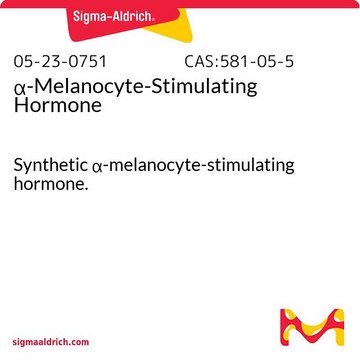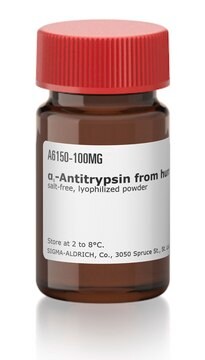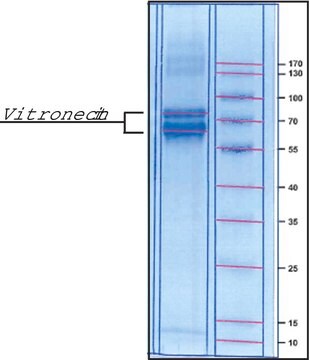SRP3318
C1 Inhibitor Peptide
≥95% (HPLC), lyophilized powder, human recombinant, expressed in CHO cells
Sinônimo(s):
C1inh, Plasma protease C1 inhibitor, Serpin G1
Faça loginpara ver os preços organizacionais e de contrato
About This Item
Código UNSPSC:
12352202
NACRES:
NA.32
Produtos recomendados
Nome do produto
C1 Inhibitor human, recombinant, expressed in CHO cells, ≥95% (SDS-PAGE), ≥95% (HPLC)
fonte biológica
human
recombinante
expressed in CHO cells
Ensaio
≥95% (HPLC)
≥95% (SDS-PAGE)
Formulário
lyophilized
potência
≤2.6 nM IC50
peso molecular
52.8 kDa
embalagem
pkg of 200 μg
Impurezas
endotoxin, tested
nº de adesão UniProt
Condições de expedição
wet ice
temperatura de armazenamento
−20°C
Informações sobre genes
human ... SERPING1(710)
Descrição geral
Plasma protease C1 inhibitor is a member of the serpin family of structurally related proteins. Recombinant Human C1 inhibitor is a highly glycosylated glycoprotein containing 478 amino acid residues (52.8kDa), corresponding to amino acids 23-500 of the C1 inhibitor precursor, and is fully functional in its ability to inhibit the C1 complex. Glycosylated C1 inhibitor migrates at an apparent molecular weight of approximately 80-90kDa by SDS PAGE analysis under reducing conditions.
Ações bioquímicas/fisiológicas
Plasma protease C1 inhibitor is the primary regulator of the immune complement system. C1 inhibitor is a protease inhibitor that functions to inhibit the complement system in order to prevent over-activation or spontaneous activation. Inhibition is achieved by binding to and irreversibly inhibiting the C1r and C1s proteases of the C1 complex, which has the effect of shutting down all subsequent downstream events in the complement activation cascade. C1 inhibitor can also inhibit various other proteases, including Kallikrein, Factor XIa, and Factor XIIa. Deficiencies in C1 inhibitor are the primary cause of hereditary angioedema (HAE, hereditary angioneurotic edema), a disease characterized by edema in the respiratory and gastrointestinal tracts. In certain clinical situations, the direct administration of C1 inhibitor can be used to treat HAE and certain other conditions.
forma física
Lyophilized from 10mM Sodium Phosphate, pH 7.5.
Reconstituição
Centrifuge the vial prior to opening. Reconstitute in water to a concentration of 0.1-1.0 mg/ml. Do not vortex. This solution can be stored at 2-8°C for up to 1 week. For extended storage, it is recommended to further dilute in a buffer containing a carrier protein (example 0.1% BSA) and store in working aliquots at -20°C to -80°C.
Código de classe de armazenamento
11 - Combustible Solids
Classe de risco de água (WGK)
WGK 3
Ponto de fulgor (°F)
Not applicable
Ponto de fulgor (°C)
Not applicable
Escolha uma das versões mais recentes:
Já possui este produto?
Encontre a documentação dos produtos que você adquiriu recentemente na biblioteca de documentos.
C1 inhibitor.
A E Davis et al.
Methods in enzymology, 223, 97-120 (1993-01-01)
C1-inhibitor deficiency and angioedema.
Carugati A
Molecular Immunology, 38(2-3), 161-173 (2001)
C1 Esterase Inhibitor (Human)
P & T : A Peer-Reviewed Journal for Formulary Management, 35, 2-3 (2010)
Sayani Mukherjee et al.
The Journal of neuroscience : the official journal of the Society for Neuroscience, 40(41), 7965-7979 (2020-09-06)
Microglia, a type of CNS immune cell, have been shown to contribute to ethanol-activated neuronal death of the stress regulatory proopiomelanocortin (POMC) neuron-producing β-endorphin peptides in the hypothalamus in a postnatal rat model of fetal alcohol spectrum disorders. We determined
In vivo biosynthesis of endogenous and of human C1 inhibitor in transgenic mice: tissue distribution and colocalization of their expression.
Vinci G
Journal of Immunology, 169(10), 5948-5954 (2002)
Nossa equipe de cientistas tem experiência em todas as áreas de pesquisa, incluindo Life Sciences, ciência de materiais, síntese química, cromatografia, química analítica e muitas outras.
Entre em contato com a assistência técnica